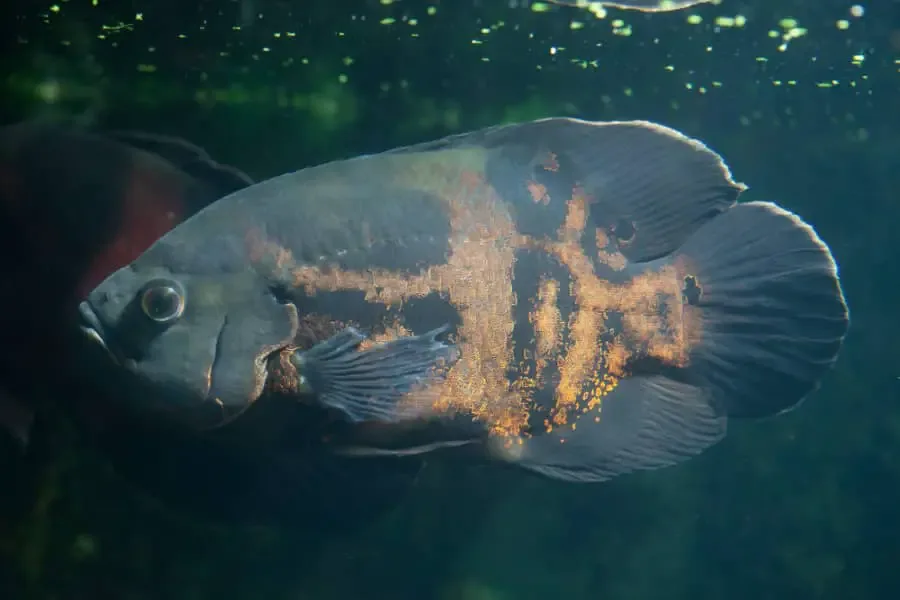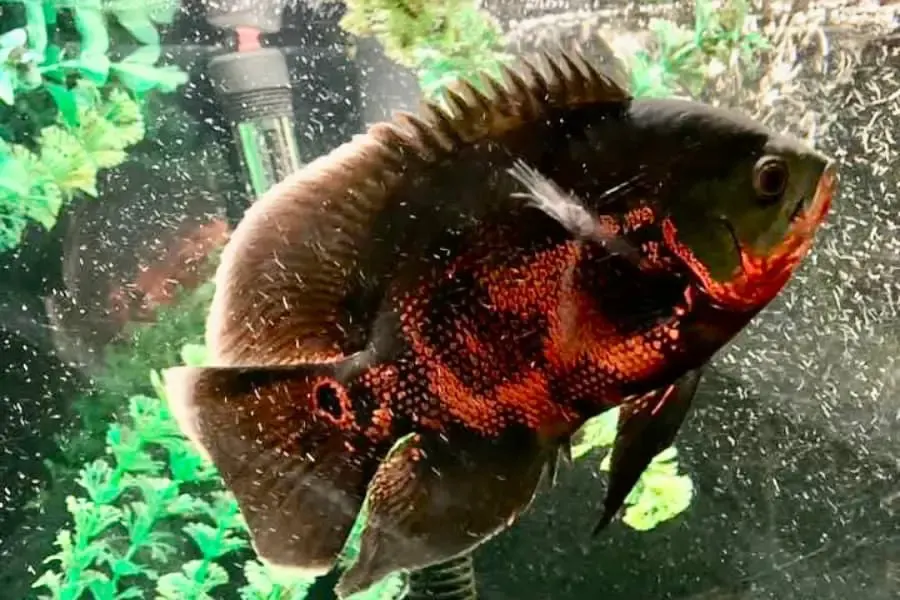This post may contain affiliate links.
The change of color in the Oscars is pretty common, but sometimes it is not. If your Oscar fish has turned gray, it might be an indication that something is not going well for the fish in the tank, which needs your attention at the earliest.
What Causes Oscar Fish To Turn Gray?

If your Oscar fish is turning gray, highly likely, it is experiencing stress or is frightened. It can be due to increasing ammonia or nitrite levels, fluctuation in temperature, incorrect pH levels, an overstocked tank, fish bullying, and being introduced to a new environment.
Is It Alarming?
Is your Oscar fish frequently changing color? If yes, there is nothing to worry about. Because Oscars do that a lot as per their mood and tank environment.
However, if the fish remains gray for a prolonged period, then it can be concerning, especially if it’s hiding and not eating as usual.
It indicates that your fish is under stress, and you must immediately identify the stressor and eliminate it.
How To Prevent Your Oscar Fish From Turning Gray?
If your Oscar fish has just shifted to a new environment, it may turn gray until it feels safe in the new territory. By the time the fish settles down, the grayness should be gone.
Unfortunately, if your Oscar remains gray, there is one of the following issues with your tank that’s causing stress to the tiny aquatic creature:
Check Water Parameters
Test your aquarium for ammonia, nitrate, nitrite, and pH level.
- Ammonia and nitrite should be at o and nitrate levels below 40 mg/l and ideally below 20 mg/l.
- Oscar fish prefer a water pH of around 7.2. Your pH should remain stable between 6 and 8 at all times.
If your test measures heightened ammonia or nitrite levels or a significant change in pH value, you need to make water changes and introduce beneficial bacteria to the tank. Also, make sure your filtration system is working fine.
Fluctuation in Temperature
Although hardy, Oscar fish are susceptible to temperature fluctuations. It can give them acute stress, and as a result, they may turn gray.
Get an aquarium heater with a built-in thermostat if you don’t already have it. Aim for 77 degrees Fahrenheit (25 degrees Celsius), and ideally, try to maintain it between 74 and 81 degrees Fahrenheit (23.5 – 27 degrees Celsius) at all times.
Avoid Overcrowding
No fish can live happily in a tank that’s too small for its size or overstocked. Ensure your Oscar has enough space to swim around.
Getting Bullied by Tank Mates
If your Oscar fish is being picked or chased by other fish in the tank, it may turn grey as a response to the stressful environment.
With too much aggression in the tank, it is best to separate the fish, especially if your Oscar is a baby yet.
Why Do Oscar Fish Change Color?

It’s a trait of Cichlids to change color. Besides stressful conditions, there are other factors that influence the change of color in Oscar fish.
Aging
As Oscar’s fish ages, it goes through a gradual but noticeable change in color.
The color of a juvenile Oscar isn’t an assurance of anything about the fish’s adult look. Therefore, never let coloration be the driving force when choosing baby Oscars.
Go for the fish that looks healthy, no matter how ugly it appears at the moment. Be assured as it grows older, the same fish may turn out to be the prettiest.
Change in Mood
Oscar fish also change color based on their mood. The darker the color, the worse the mood. The lighter, the better the mood.
For instance, Oscars have a high temperament, so sometimes the temporary change in color is nothing but a tantrum thrown at you.
It’s hard to say which color your fish may display at any given mood. You can only figure it out by observing and noticing the pattern in the fish.
All Oscars are different, and while many depict similar colors in relation to their mood, it significantly varies.
Illness Or Poor Water Quality
Another reason why Oscar fish may change color is due to sickness or when water quality is not optimum.
If your Oscar appears pale, you must test the water parameters to see what’s happening in your aquarium.
Also, keep an eye on the fish if it starts to hide more, seems lethargic, and shows no interest in food. Likely, the poor little creature isn’t feeling well.
How to Bring Out Oscar Fish Best Colors?
Getting the intense coloration of an Oscar, or any other fish, depends on water quality, diet, and genetics.
All three are equally important, but we only have control over diet and water quality unless we breed the fish ourselves.
Always keep your aquarium clean, maintaining the ideal water parameters above. Add color-enhancing cichlid food to the diet, with frozen krill as a treat, and you shall experience the best coloration of your Oscar fish.
Some Related Questions
What does a sick Oscar fish look like?
The common signs that indicate illness in Oscar fish include lethargy, loss of appetite, clamped fins, and change in appearance, such as the darkness of skin or fungus patches on the body.
How do you make Oscar fish happy?
Oscars are hardy, easy to care for fish, and don’t need much to be happy. If all you can do is, maintain a clean tank with a steady temperature of 74–80°F (23–27°C) and provide the fish with a meaty diet, they will thank you.
Final Words
We hope, by now, it’s crystal clear that an Oscar fish may turn grey when it’s displeased or stressed due to water conditions or surrounding. Once the stressor is removed, the fish must return to its original color.
If you have tried everything from your side, but your Oscar couldn’t seem to be relieved as the grayness persists, we’d advise calling on an expert or a fish Vet before it’s too late.
